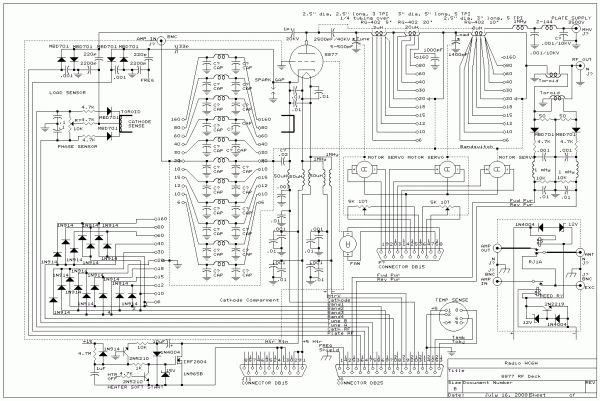8877 Linear Amplifier RF Circuitry
Heater -- A voltage ramped heater soft start is included. The operation of this circuit is explained in detail here.
The Cathode Circuit -- The cathode is RF isolated by means of a trifilar transformer which simultaneously isolates the heater supply.
Input Network --
A switched pi-net input is employed with a Q of 5 on all bands except 80 and 160 meters where a Q of 2 is selected.
The Plate Circuitry -- Note that a 6 meter position is shown on the bandswitch. The tube capacitance plus the minimum tuning C might suggest the possiblity of running on this band though, strays may conspire to preclude operation at 50 Mhz.
Tune & Load caps -- Vacuum caps, driven by small gearhead motors, are employed for both the tuning and loading for their great range and small size. The load cap is padded with a mica part for 160 meters.
Pi-L coil --
The Pi-net is designed for a nominal Q of 12. The L point is designed for 250 ohms nominal. The Pi-L coil is formed from RG-402 with 1/4" copper tubing around the leading few turns for 14 MHz and higher frequency operation. The plate voltage is fed through the center conductor and the outer conductor of the coil is coupled to the plate through the typical plate coupling capacitor. The PI-L coils are switched by a small gearhead motor which also drives the input network select switches plus an additional deck with diode encoding of the switch position.
Where's the plate choke!? --
A rather smallish choke, connected to the center conductor of the coil described above, is connected at the 50 ohm output point to isolate the plate supply. A detailed explanation of this technique may be seen here.
Tune (Phase) Sensor --
The cathode current is sensed by a toroidal transfomer with a high impedance output providing a 90 degree phase shift and combined with a sample of the plate voltage.
Load Sensor --
This is a typical cathode voltage / plate voltage balance circuit.
Fwd / Ref Power Sensor --
A cross coupled transformer design is used for wide frequency coverage.
Frequency takeoff --
A sample of the input signal is sent to the microprocessor where it is directly counted to determine the input frequency.
Temperature Sensor --
An infrared temperature sensor is aimed at the tube where the ceramic meets the plate structure.
QSK Relays --
A reed relay is employed for the input switching and a vacuum relay for the antenna switch. The relay coils are connected in series and engerized from a high voltage source, with a voltage limit across the reed relay and a current limit.
